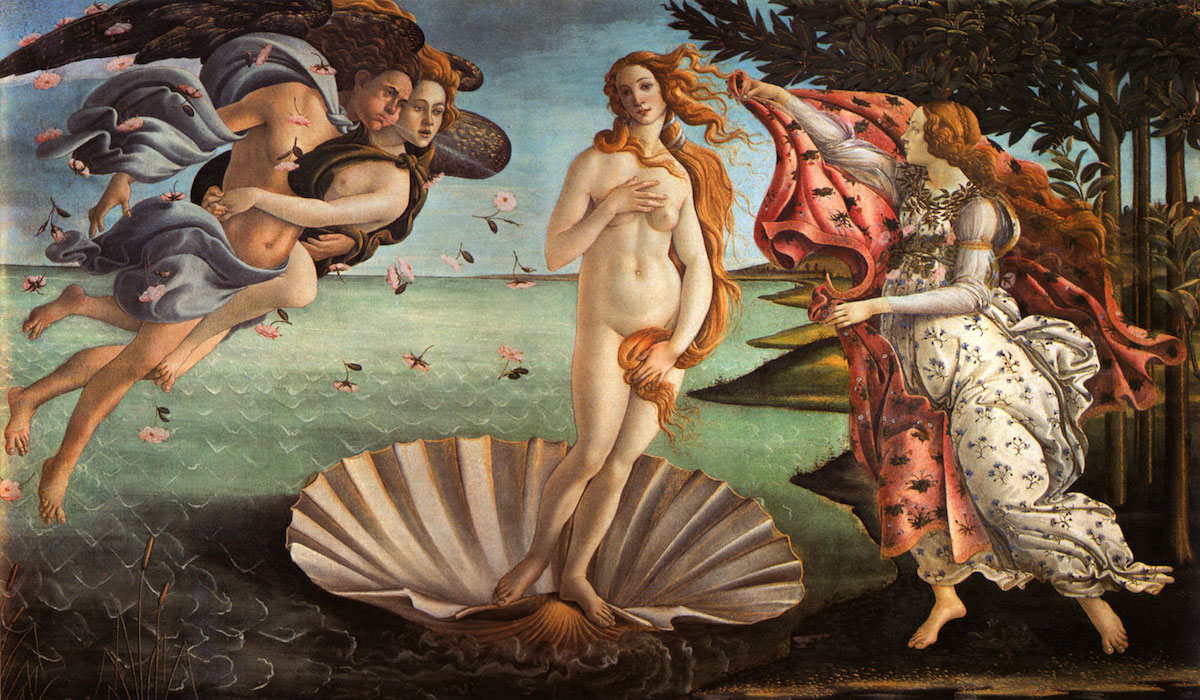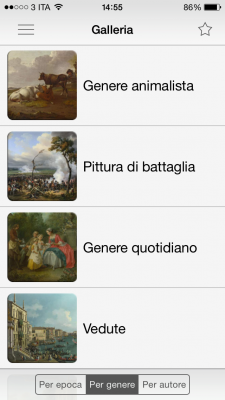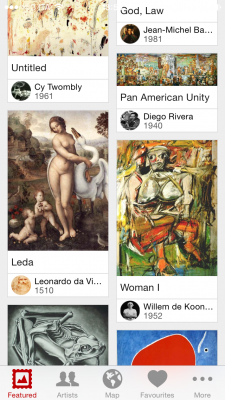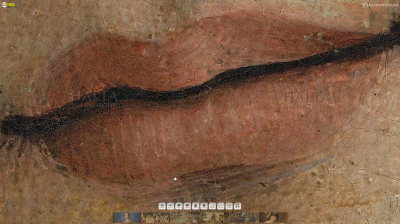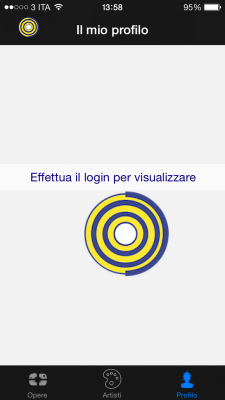Spesso siamo pervasi da un pensiero comune: l’arte abita in un mondo a sé.
E per riverenza, ammirazione e timore lo abbiamo volutamente collocato ad anni luce dal nostro.
Ma l’arte vive oggi, si evolve oggi, si trova qui nel nostro spazio e sfrutta i nostri stessi mezzi, e noi non sempre ce ne accorgiamo.
Proprio per questo vi offro quattro piattaforme che sintetizzano quattro delle cose fondamentali che la tecnologia contemporanea ha l’obbligo (e soprattutto la possibilità) di fare nei confronti dell’arte:
SPALANCARE LE PORTE DEI MUSEI
Great Museums e World of Painting:
Un primo esempio di applicazioni pensate e realizzate unicamente per godere dell’arte in ogni istante e nella maniera più agevole possibile, affinché nessuno possa dire “non ho mai tempo per farlo”.
Il primo pacchetto toglie il velo alle opere del Louvre, della National Gallery di Londra, della National Gallery of Art di Washington e del Metropolitan Museum of Art.
Il secondo raccoglie i migliori ritratti e paesaggi della storia dell’arte e le opere dell’Impressionismo, della pittura europea, di quella russa e del Barocco.
Lo sviluppatore è Evolution Games LLP, queste dieci app sono disponibili sia in una versione gratuita sia in una versione a pagamento (si tratta di 1,99€ ognuna, o 5,99€ nel caso si acquisti il primo pacchetto completo, 7,99€ il secondo).
Sono estremamente facili da usare:
- Si può scegliere di scorrere tra i dipinti in base all’epoca, al genere o all’autore
- Di solito ci sono una o due opere per ogni pittore
- C’è una breve biografia per ogni artista e una breve presentazione di ogni quadro
- C’è la barra di ricerca per puntare ad un’opera nello specifico
- Ogni immagine può essere zoommata, scaricata nella libreria del telefono, segnata tra i preferiti all’interno dell’applicazione, vista in HD, inviata per e-mail o condivisa su Facebook
- C’è uno spazio per ascoltare musica classica
La sostanziale differenza tra la versione gratuita e quella a pagamento sta nel numero di opere a cui si può accedere: si passa da 180 o 400 circa a 1400, 1900 o 2000, più la possibilità di vedere le immagini su una TV con una connessione via cavo.
Il vantaggio maggiore è quello di poter scaricare le opere nel rullino fotografico e di poter usare l’applicazione senza che sia necessaria una connessione internet, inoltre la versione gratuita offre una risoluzione HD niente male e la suddivisione è efficace, ma dà molto l’idea di un dolce assaggio più che di excursus nella storia dell’arte.
ABBATTERE LE BARRIERE SPAZIO TEMPORALI
Wiki Art:
L’applicazione migliore per gustare appieno l’arte: è totalmente gratuita, copre un arco temporale vastissimo e ha un assortimento eccellente di generi e stili artistici, inoltre è parte del progetto WikiArt.org.
È stata creata da un gruppo di volontari e racchiude più di 110.000 pezzi d’arte in digitale realizzati da più di 2000 artisti da tutto il mondo.
L’iniziativa è non-profit e si può fare una donazione per aiutare nei costi infrastrutturali e nello sviluppo dell’app stessa, che è costante e senza limiti.
Funziona in modo molto simile alle precedenti, con la differenza che, in più, offre una mappa mondiale sulla quale sono segnate tutte le città di origine degli artisti di ieri e di oggi, e le informazioni su ognuno di loro sono dettagliate e approfondite, poiché l’applicazione manda direttamente alla pagine di Wikipedia dedicata all’artista in questione.
Si impara molto e facilmente, si prende familiarità con l’arte e si fanno scoperte interessanti.
SUPERARE GLI OSTACOLI FISICI
Haltadefinizione.com:
Stavolta un sito internet, che permette di osservare le più grandi opere d’arte a distanza ravvicinata e ad altissima definizione.
Ogni pennellata, ogni increspatura o dettaglio, sono visibili grazie a fotografie di milioni di pixel scattate con macchine fotografiche altamente professionali.
Posso confermare che l’effetto è sorprendente: non c’è occhio umano che arrivi a notare tanti dettagli quanti quelli che può svelare Haltadefinizione. Qualsiasi dipinto o affresco stiate osservando vi sembrerà di conoscerlo per la prima volta, sia che vi sia capitato di incontrarlo in un museo o in una cappella, sia che l’abbiate incrociato sulle pagine di un libro.
Le foto sono stare realizzate su concessione del Ministero per i Beni e le Attività Culturali e per accedere alla galleria completa basta iscriversi gratuitamente al sito web.
CREARE UN MERCATO PARLANTE
Ubiquitous Art:
La ciliegina sulla torta.
Il Mobile Social Network creato dagli artisti per gli artisti.
UbqArt è la piattaforma per giovani talenti, per semplici appassionati e per acquirenti. Non si tratta solo di godere dell’arte, ma anche di scoprirla ed eventualmente discuterne.
È una community che dà l’opportunità di emergere e farsi notare, di crearsi un seguito e un pubblico, nonché di trovare compratori e di aggiornarli sui risvolti della propria attività e sui progetti in cantiere. Un grande mercato d’arte online privo di intermediari, e contemporaneamente un Social per commentare, votare e ripubblicare opere contemporanee, un Network per trovare e localizzare studi, atelier e vernissage. Ubiquitous Art è effettivamente “l’Arte in ogni luogo”, e per questo rappresenta un trampolino di lancio di stampo moderno e democratico.
Oggi il nostro rapporto con l’arte è alquanto singolare.
È un po’ come quando si allontana chi si ha paura di ferire o di non capire: l’arte è, soprattutto in Italia, la cattedrale congelata della nostra nazione.
Questo atteggiamento ci ha portato a trattarla come un’anziana sconosciuta: ha le sue gallerie, i suoi musei, le sue mostre, e noi non abbiamo il diritto di catapultarla nel nostro mondo pieno di smog, internet e rifiuti tossici. Per di più, non la conosciamo abbastanza, e questo ci convince definitivamente che non sia roba per noi. Ma, se anche la ritenessimo avvicinabile, penseremmo di doverci dirigere sempre noi verso di lei.
In parte è vero: merita questo tipo di rispetto, e merita che si entri nel suo tempio in punta di piedi.
Ma se venisse lei da noi? Sarebbe sbagliato?
Credo nel valore di un museo, di una galleria, di una struttura o di uno spazio urbano che permettano non solo di vedere l’arte, ma anche di respirarla. Però, credo anche nell’accessibilità e nell’uso buono della tecnologia, nonché nel dialogo imprescindibile tra il nostro passato e il nostro futuro.
[divider]ENGLISH VERSION[/divider]
There seems to be an objective truth concerning art: it lives in its own world, conflicting with ours. This is what most people think. But now it’s high time people changed their mind.
Art lives and evolves every day, in our reality, though we are not often able to notice this hidden presence. I’m here to show you 4 platforms, that is, 4 efforts that technology has the duty (and above all, the possibility) to make for art:
TO OPEN WIDE THE DOORS OF MUSEUMS Great Museums e World of Painting:
This is the very first example of apps specifically thought up to enjoy art in every moment and in an easy way. The first platform shows the Louvre, the London National Gallery, the Washington National Gallery of Art and the Metropolitan Museum of Art’s masterpieces.
The second one features a huge collection of some of the best portrays and landscapes ever made in the whole history of art, together with the works of Impressionism, of both the European painting and the Russian one together with Baroque’s masterpieces.
The platform developer is Evolution Games LLP. The 10 apps are available both in a free version and in a version with fee (it’s basically 1,99€ each, or 5,99€ in case you purchase the complete set, or 7,99€ for the second one)
It’s extremely easy to use them. You are free to select the paintings on the strength of the époque, the genre or the author. There are usually one or two works for each painter. You can find a short biography for each artist and a short introduction for each painting. By using the upper task bar, it is possible to pick a specific work of art out. Every image can be zoomed, downloaded in your phone’s library, marked as a favorite in the app, watched in HD, sent by email or shared on Facebook. You can also listen to classical music while watching your favorite masterpieces.
The basic difference between the app free version and the version with fee stays in the number of works that are available: from 180 or 400 works on average to 1400, 1900 or 2000 paintings. But there’s also another difference between the two apps and it concerns with the chance to watch images on a TV with a wired connection. The main advantage is that you can download the paintings on your cameras. You are also free to use the app without any Internet connection, which is good. Furthermore, the free version offers a HD resolution.
TO TEAR DOWN SPACE AND TIME BARRIERS Wiki Art:
Wiki Art is the app that I recommend using if you want to enjoy art: it is totally for free and it covers a wide time frame and it has an excellent range of genres and artistic styles. Moreover, it is part of WikiArt.org project. It was though up by a group of volunteers and it collects more than 110.000 work of art, which were realized by more than 2.000 artist all over the world, in digital format. Wiki Art is a non- profit project, but you can always make donations to contribute to the infrastructural costs and the app’s development. It works the same way as the previous apps. There is only one difference: Wiki Art offers a worldwide map in which all the artists’ hometowns are mentioned. Moreover, the information about each artist is detailed, being the app linked with Wikipedia. You learn in very easy way and you become familiar with art while making important discoveries. It is what I can tell you, speaking from experience.
TO OVERCOME PHYSICAL OBSTACLES Haltadefinizione.com:
This time I am going to show you a website which gives you the opportunity to take a look at the most beautiful masterpieces of art from a very short distance and in an extremely high definition. Every single detail can stand out thanks to the millions of pixel photos that were taken using professional cameras. I can assure you that the effect is absolutely astonishing. There’s no human eye that can be able to spot the huge quantity of details shown by Haltadefinizione. The photos were taken by courtesy of the Ministero per I Beni e le Attività Culturali and it’s possible to enter the complete gallery by signing up for free to the website.
TO CREATE A TALKING MARKET Uniquitous Art:
The icing on the cake. The Mobile Social Network was created by the artists and for the artist. UbqArt is the platform for the young talented people, for people into art and for purchasers. It’s not only about enjoying art. It’s a community, which gives the opportunity to the artists to stand out and be noticed, to create a group of followers, to find purchasers and keep them up to date. It’s a huge online art market, without any mediator. At the same time is a Social in which you can comment, vote and publish contemporary works. Uniquitous Art is, actually, everywhere art.
Nowadays, our relationship with art is rather singular. Art is, especially in Italy, the frozen temple of our nation. We tend to keep art away from us, as something we cannot understand. This behavior has led us to discriminate it. Art stays in its galleries, in its museums, but it cannot join our world. Moreover, we don’t know it well, and this has convinced us that art is not something for us.
But what if art approached to us? Would it be wrong? I do believe in the importance of museums and art galleries because they give us the chance to benefit from art. But I also believe in the availability and in the proper use of technology, together with a necessary link between our past and our future.
Traduzione a cura di Elisa Lombardi

